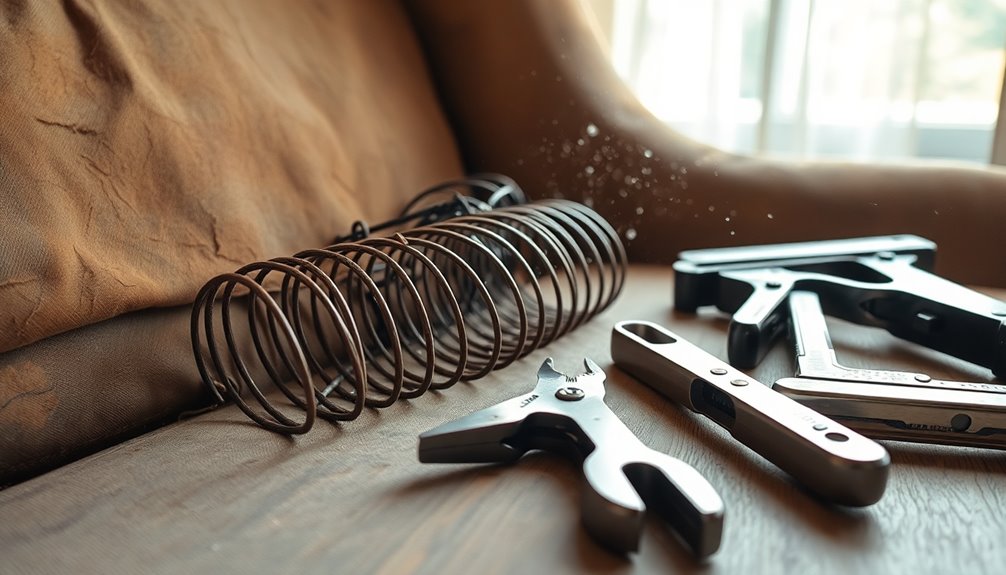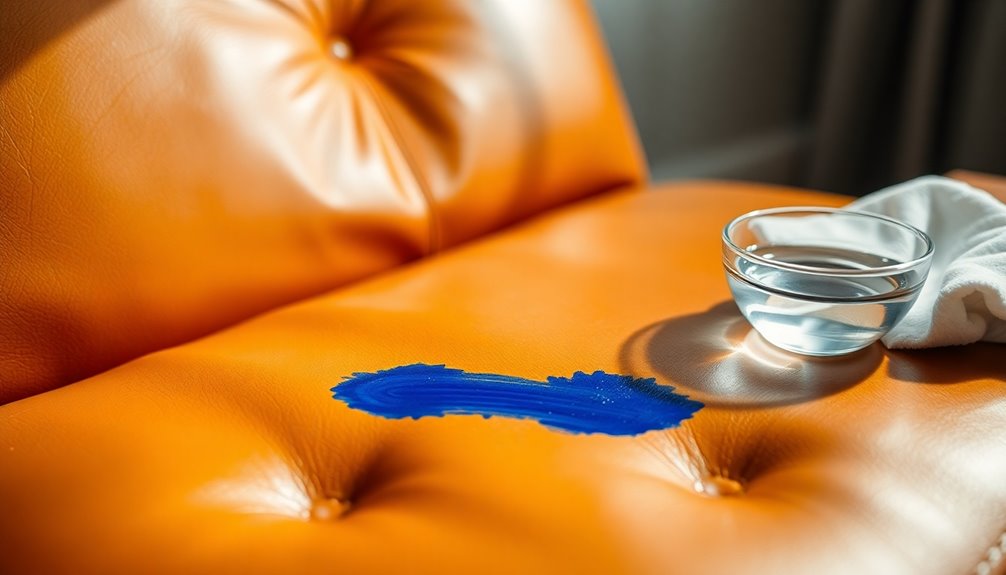To fix your sofa springs, start by inspecting them for any damage or sagging. If springs are loose, reattach them securely with the right tension. You can reinforce the frame by adding wooden supports or metal brackets, ensuring stability. If springs are broken, consider replacing them with new ones from a furniture store. Additionally, check the sofa's joints and support beams and use wood glue to secure any loose areas. Regular maintenance will prolong their life, and you'll find more tips for ensuring a comfy sofa as you explore further.
Key Takeaways
- Inspect the springs for any visible damage, like breaks or sagging, and replace as needed to restore support.
- Reattach loose springs securely using appropriate tension to maintain comfort and functionality.
- Use wooden supports or metal brackets to reinforce weak areas in the sofa frame that support the springs.
- Add corner braces and wood glue to joints for extra stability and to prevent wobbling during use.
- Regularly check and maintain the springs to ensure they remain securely attached and in good condition.
Introduction
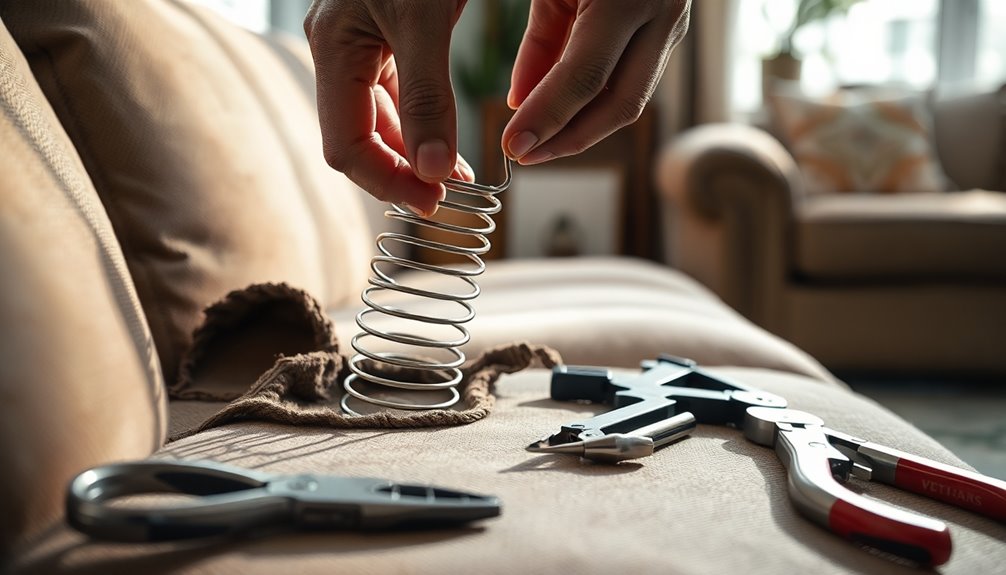
When it comes to keeping your sofa in top shape, routine upholstery care is essential. You'll want to learn fabric-specific cleaning techniques to maintain its appearance, especially if you have pets that might leave odors behind. Addressing issues like pet urine smell can greatly enhance your sofa's comfort and longevity.
Routine Upholstery Care Tips
Regularly caring for your sofa upholstery can significantly extend its lifespan and maintain its appearance. Start by inspecting your sofa springs for signs of wear, like popping or sagging, so you can address issues before they worsen. Flipping or rotating your cushions frequently ensures even wear and prolongs the lifespan of both the cushions and springs.
Don't forget to dust and vacuum your sofa regularly, focusing on the crevices and undersides. This prevents debris from interfering with the spring mechanism. Using a protective cover or throw over your sofa is another smart move; it shields your upholstery from spills and pet hair, which contribute to wear and tear.
To keep everything in top shape, schedule professional upholstery cleaning every 1-2 years. This helps maintain the fabric's integrity and supports the overall structure of your sofa, including the springs. Incorporating these routine upholstery care tips into your maintenance schedule will not only enhance the beauty of your sofa but also ensure its durability for years to come. So, take these steps seriously to enjoy a comfortable and stylish living space!
Fabric-Specific Cleaning Techniques
Choosing the right cleaning technique for your sofa fabric is crucial to keeping it looking great and lasting longer. Different fabric-specific cleaning techniques are essential for various materials, so you'll want to know how to care for your specific type.
For leather sofas, use a damp cloth to wipe down the surface, making sure to follow up with a leather conditioner. This not only cleans but also protects the leather from drying out or cracking. If your sofa is upholstered in microfiber, mix water with mild dish soap and apply it with a soft cloth. This method gently lifts stains without damaging the fabric.
Cotton fabrics respond well to steam cleaning, which effectively removes dirt and allergens while being gentle on the fibers. Regardless of the fabric, always test any cleaning solution on a small, inconspicuous area first. This step ensures that the cleaning method won't alter the fabric's color or texture. By using these fabric-specific cleaning techniques, you can maintain the appearance and longevity of your sofa, keeping it comfortable and inviting for years to come.
Eliminating Pet Urine Smell
Dealing with pet urine smell can be a frustrating experience, but tackling it promptly can make a world of difference. First, immediately blot the area with paper towels to absorb as much urine as possible. This step is crucial, especially if the odor has seeped into your couch springs. Next, create a mixture of equal parts vinegar and water to neutralize the odor. Apply this solution to the affected area using a cloth or spray bottle.
Once you've applied the vinegar solution, sprinkle baking soda over the area. Baking soda works wonders in absorbing lingering odors, so let it sit for several hours or overnight. After that, rinse the area with clean water and blot dry to remove any cleaning solution residue.
If the smell persists or if you're dealing with deep stains, consider using enzymatic cleaners specifically designed to break down pet urine components. These products can be incredibly effective in eliminating stubborn odors that may have settled deep into your couch springs. By following these steps, you can restore your sofa to its original freshness and enjoy a cleaner living space.
Sofa Stain Prevention Tips
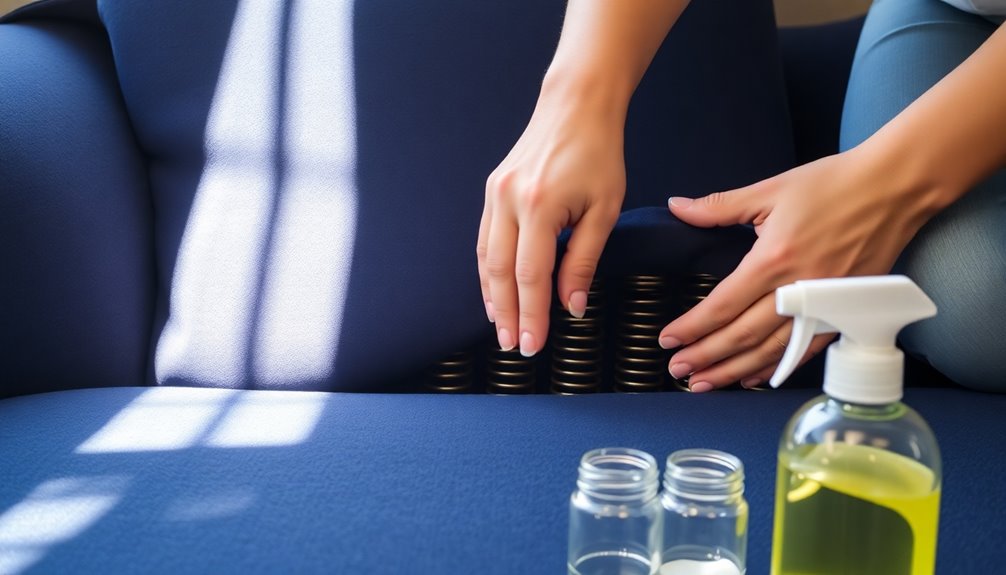
To keep your sofa looking fresh, consider selecting scratch-resistant fabric that can withstand daily wear and tear. Stylish slipcovers also offer an easy way to protect your upholstery while enhancing your decor. Plus, rotating your cushions regularly helps maintain their shape and prevents uneven wear, making your sofa last longer. Additionally, implementing scratching posts can help redirect your cat's scratching behavior and protect your sofa from damage.
Scratch-Resistant Fabric Selection
When selecting fabric for your sofa, it's essential to prioritize scratch-resistant options that can withstand daily wear and tear. Look for fabrics labeled as "scratch-resistant" or "pet-friendly," like microfiber or tightly woven synthetic blends. These materials minimize damage from pet claws and everyday use.
Additionally, consider upholstery treated with stain repellents. This treatment helps prevent liquid absorption, making it easier to clean spills when they happen. Fabrics with a high rub count, typically above 30,000, indicate durability against abrasion, ensuring your sofa remains intact through years of relaxation.
Evaluate the ease of cleaning as well. Fabrics that are machine washable or can be wiped down with a damp cloth are practical choices for maintaining a fresh appearance. Lastly, opt for darker colors or patterned fabrics to effectively camouflage potential scratches and stains. This way, your sofa not only stays looking good but also retains its aesthetic over time.
Stylish Slipcovers for Protection
A stylish slipcover can transform your sofa while providing essential protection against stains and spills. Not only do slipcovers enhance the aesthetic of your furniture, but they also act as a barrier against everyday wear and tear. When selecting a slipcover, look for materials like cotton or polyester blends, as they're durable, machine washable, and resistant to fading.
Fitted slipcovers that hug your sofa's contours create a tailored look, while loose-fit styles offer a more relaxed vibe. For homes with children or pets, consider slipcovers with water-resistant or stain-resistant treatments to safeguard against accidental spills. These features make maintenance a breeze and help keep your furniture looking fresh. Additionally, choosing slipcovers in durable materials can significantly enhance their longevity and effectiveness.
To prolong the lifespan of your slipcovers, wash and maintain them regularly. This simple step not only keeps your sofa stylish but also prevents permanent stains from taking hold. With the right slipcover, you can enjoy the beauty of your furniture without the constant worry of damage, allowing you to relax and enjoy your space to the fullest.
Cushion Rotation Schedule
Cushion rotation is an essential practice that helps maintain the comfort and appearance of your sofa. By rotating your cushions every few weeks, you promote even wear and prevent permanent sagging, ultimately extending the lifespan of your sofa. If your cushions are reversible, make it a habit to flip them regularly. This simple action helps maintain their shape and support.
To keep your sofa looking its best, establish a cleaning schedule using appropriate upholstery cleaners. Regularly cleaning your cushions will help prevent stains and preserve the fabric's appearance. It's also a good idea to encourage family members to use different seating areas. This distributes pressure evenly across the sofa's surface, reducing the chances of uneven wear.
When your sofa isn't in use, consider storing the cushions in a dry, ventilated area. This can help prevent moisture buildup and potential mildew growth. Following a consistent cushion rotation schedule, along with these tips, will help ensure your sofa remains comfortable and visually appealing for years to come. By taking these proactive steps, you'll enjoy your sofa while keeping it in top shape.
Couch Frame Reinforcement Techniques
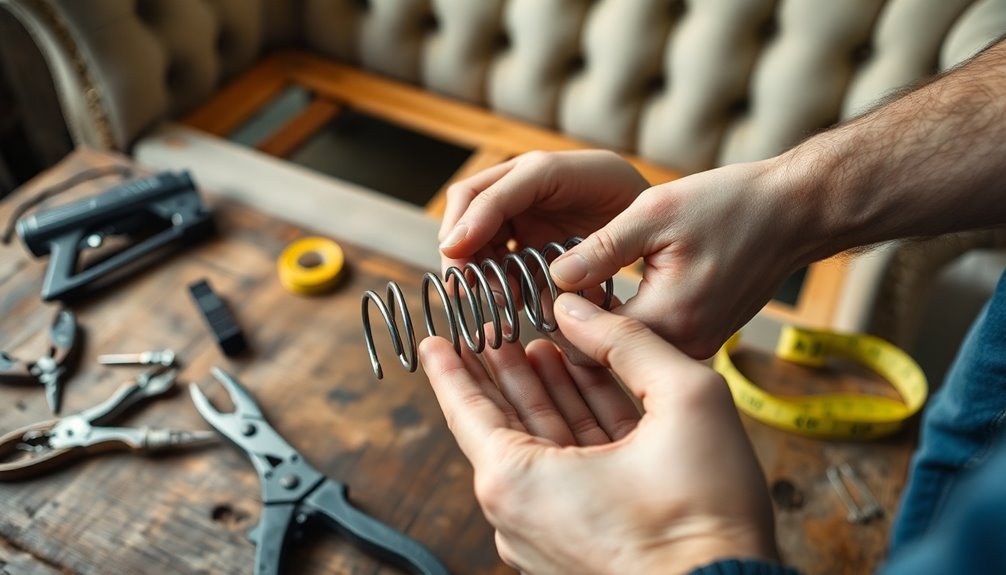
When you're reinforcing your couch frame, start by inspecting for any signs of damage, especially at the joints and support beams. You can use wooden supports or metal brackets to strengthen weak areas, ensuring everything's securely attached. Adding corner braces and applying wood glue can further enhance stability, giving you a cozy seating experience for years to come.
Frame Weakness Solutions
To effectively reinforce a weakened couch frame, you can implement several practical techniques that enhance its stability and longevity. First, consider adding L-brackets to the corners of the frame. These brackets provide essential support and help prevent future wobbling. Next, if you notice any broken or damaged wooden pieces, replace them with matching hardwood to maintain the original structure.
Utilize wood glue alongside screws to secure joints, ensuring they don't separate over time. Another effective frame weakness solution is to install additional cross supports or braces beneath the seat area. This step helps distribute weight more evenly, reducing the chance of sagging.
Lastly, don't forget to check the springs. Make sure they're all reattached securely to the frame. Proper tension is crucial for supporting your cushions effectively. By following this step-by-step guide, you can breathe new life into your furniture and prolong its use. With these techniques, your couch will be stable and ready for years of comfort.
Leather Repair Techniques
Leather repairs can significantly enhance the overall durability and appearance of your couch. Before you start reinforcing the couch frame, make sure to inspect the leather for any tears or wear. Addressing these issues first ensures that your repairs won't compromise the aesthetic of your couch.
To bond any loose areas of the frame, utilize high-quality leather adhesive, making sure it creates a secure and lasting reinforcement. For added support, consider using leather patches cut from surplus material. These patches can cover damaged areas and boost the structural integrity of your couch.
Next, reinforce the frame by applying additional brackets or corner supports where necessary. Make sure you secure them with screws that won't penetrate the leather, preserving its look and feel.
Finally, regularly check the reinforced areas for signs of wear or loosening. By doing this, you'll maintain the couch's stability and appearance over time, ensuring that your hard work pays off. With these leather repair techniques, you'll not only extend the life of your couch but also keep it looking great.
Cozy Seating Experience
Your couch's comfort largely depends on its frame's stability and support. To ensure a cozy seating experience, you might need to reinforce the frame. Start by replacing any damaged pieces with new, accurately measured wood. This step is crucial for maintaining the sofa's structural integrity and longevity. Once you've replaced broken components, make sure to securely reattach the springs to their clips. This will help maintain the proper support and comfort you expect from your couch.
Using wood glue and screws at joint connections can add strength and prevent future sagging or breakage. Additionally, consider adding corner blocks to the frame; these provide extra support at stress points where joints meet, enhancing overall stability.
Regularly inspecting and tightening screws and joints is a simple yet effective way to maintain a sturdy frame. By doing this, you can prolong the life of your couch and keep it comfortable for years to come. Remember, taking these reinforcement steps not only helps you keep the couch but also ensures it stays a cozy spot for relaxation and enjoyment.
Cushion Firmness Adjustments
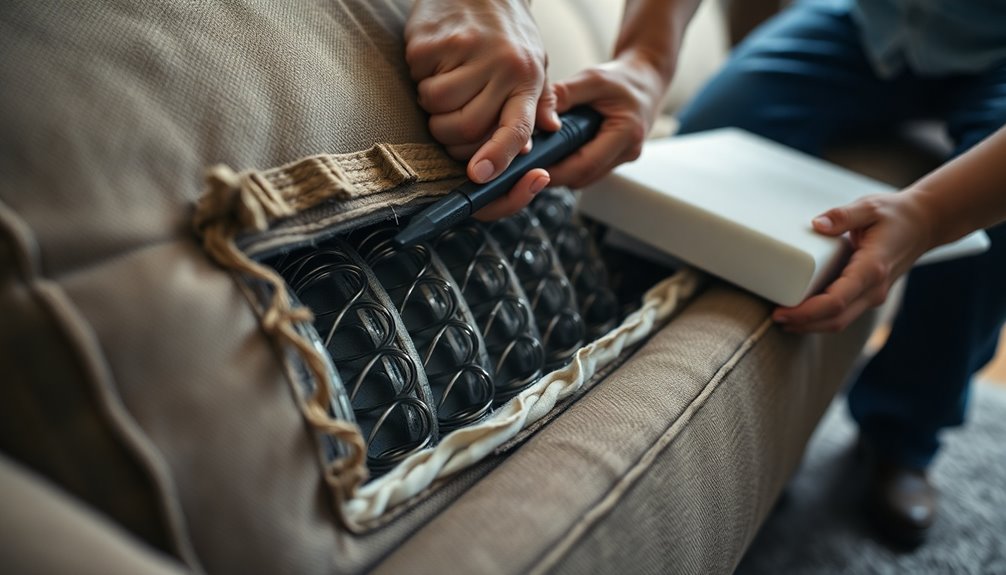
Maintaining cushion firmness is essential for both comfort and the overall lifespan of your sofa. To improve cushion firmness, start by flipping or rotating the cushions regularly. This simple practice promotes even wear and helps prevent sagging, keeping your cushions still intact longer.
You can also enhance comfort and firmness by beating the cushions. Doing this loosens and redistributes the filling, giving them a refreshing boost. If your cushions have lost their shape over time, consider adding more stuffing. High-density foam is a great option that effectively restores firmness.
For a temporary fix, think about utilizing a sofa topper made of memory foam or latex. This extra layer provides additional support and enhances cushion firmness when needed.
Lastly, don't forget the importance of regular maintenance. Cleaning and fluffing your cushions can preserve their firmness and prolong their lifespan significantly. By incorporating these adjustments, you'll enjoy a more comfortable seating experience while ensuring your sofa remains inviting for years to come.
Ongoing Maintenance for Upholstery
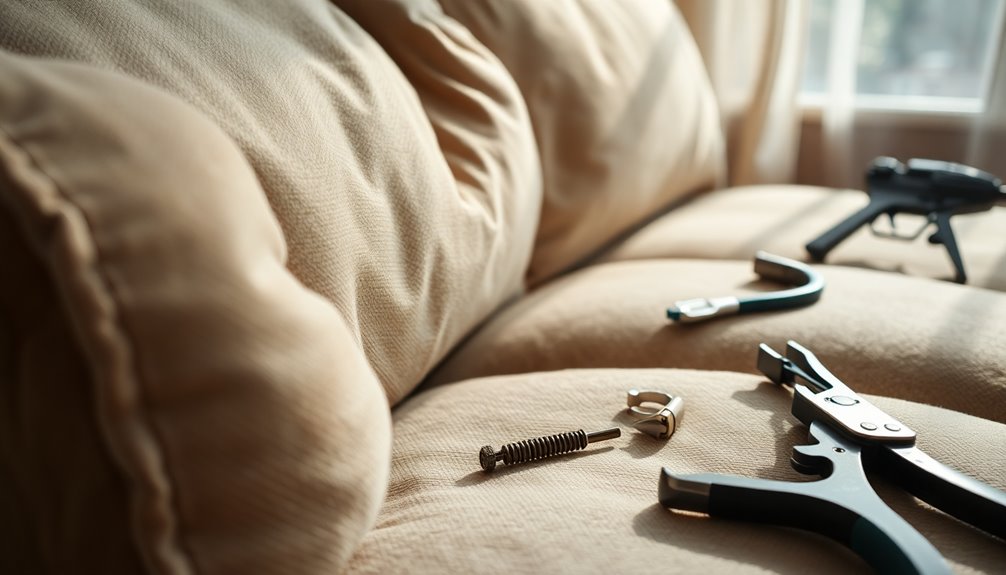
To keep your upholstery looking fresh and extend its lifespan, regular maintenance is key. Start by rotating and flipping your cushions every few months. This simple practice promotes even wear and helps prevent sagging, keeping your upholstery looking its best.
Next, regularly clean your upholstery with appropriate fabric cleaners to eliminate dirt and oils that can degrade the materials over time. It's essential to check the springs and frame periodically for any signs of wear or damage. Addressing these issues promptly can save you from more extensive repairs down the line.
Using protective covers on your cushions and upholstery can also be a game changer. They shield against spills and stains, which can significantly extend the lifespan of the fabric.
Finally, don't forget to schedule professional cleaning every 1-2 years. This will not only maintain the appearance of your upholstery but also ensure its integrity, so it continues to look good for longer. By staying on top of these maintenance tasks, you'll enjoy your upholstery for years to come while keeping it in top-notch condition.
Conclusion
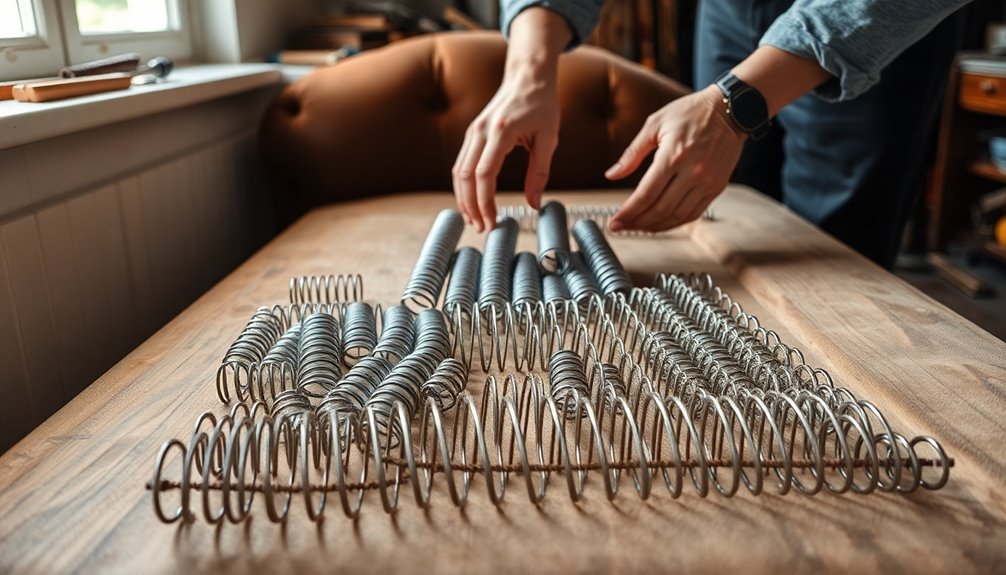
Fixing sofa springs is a crucial step in ensuring your furniture remains comfortable and supportive. By taking the time to inspect for displacements or breaks, you can identify issues that may be affecting your sofa's performance. Flipping the couch over and removing the legs provides better access for a thorough examination. If you find that the springs need retying, using the eight-way tie method will help align them properly, offering even support across the seating area.
While temporary fixes like placing plywood under cushions can provide some immediate relief, they won't solve the underlying problems. If the springs are intact but sticking up, inspect the webbing closely, as deterioration there might be the culprit. In cases where the repairs seem too complex, hiring a professional upholsterer can be a wise choice. They not only ensure proper alignment but also address any additional issues effectively.
Incorporating these steps into your home improvement routine can extend the life of your sofa, keeping it comfortable and supportive for years to come. Take action today so you can enjoy your furniture's full potential!
Frequently Asked Questions
Can Springs in a Sofa Be Repaired?
Yes, you can repair springs in a sofa. If they're popped out of place or damaged, retying or replacing them is often possible. You'll want to inspect the springs regularly to catch any issues early. Using techniques like the eight-way tie method can help secure them effectively. For immediate support, consider placing plywood under the cushions. If the repairs seem complex, hiring a professional upholsterer might be your best bet for a lasting solution.
How Much Does It Cost to Fix a Spring on a Couch?
The cost to fix a spring on your couch typically ranges from $100 to $300. If you opt for professional help, expect to pay between $50 and $150 per hour for labor, with additional materials costing another $20 to $100. If you’re handy, DIY repair kits can save you money, starting at around $10. Just make sure the repair cost doesn’t exceed 50% of your couch’s value before deciding. For those considering a DIY approach, there are plenty of online tutorials and DIY repair kits for couch springs that can help save money. It’s important to carefully assess the extent of the damage and consider the potential costs before deciding whether to attempt the repair on your own. In addition to considering the value of the couch, it’s also helpful to research and gather bathroom remodel tips before starting a home improvement project.
How to Fix Sagging Springs in a Sofa?
If you're dealing with sagging springs in your sofa, start by flipping it over and removing the legs for inspection. Look for any broken or overstretched springs. If you find damage, replace them. For intact springs that sag, retie them using an eight-way tie method. You might also reinforce them with wire or twine. If sagging persists, place a piece of plywood under the cushions for temporary support while you consider long-term solutions.
How to Fix a Couch That Sinks in the Middle?
If your couch sinks in the middle, start by checking the springs and webbing for damage. If the springs are intact but the webbing is worn, try retying them using the eight-way tie method. You can also place plywood sheets under the cushions for temporary support. Rotating or flipping the cushions might help, too. If you're unsure about repairs, don't hesitate to call a professional upholsterer for assistance.
